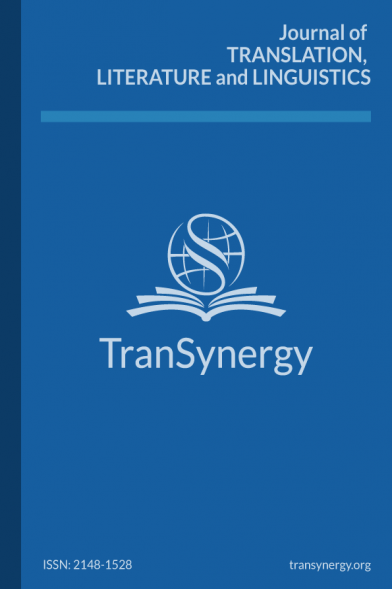How Retranslation Affects the Visibility of the Translator: Analysis of Turkish Translations of Jack London’s The Call of the Wild
Retranslation Hypothesis, introduced by Berman (1990), emphasizes that the initial
translation of a source text is closer to the target reader and culture and the retranslations of
a text become closer to the source text in time. On the other hand, Venuti (1995) claims that
domestication makes the translator invisible to the target-text readers, whereas
foreignization moves the readers towards the source text and culture. The relation between
retranslation and the visibility of the translator will be discussed identifying whether
Retranslation Hypothesis is verified in the Turkish translations of Jack London’s The Call of
the Wild and whether the translator’s visibility increases by retranslations. The study
analyses the translators’ visibility through foreignization and domestication strategy use
within the scope of Venuti’s Invisibility Theory. The culture-specific items were selected from
the source text and separated into six categories in accordance with Newmark’s (2010) and
Espindola’s (2006) CSI categories. The foreignization and domestication strategies used in
the CSIs in the three translations were comparatively analyzed. The findings showed that the
first translation’s translator (1997) was the most visible translator, the most recent
translation was the second most visible (2015), and the second translation (2009) was the
least visible translator. The translator’s visibility and use of foreignization strategy do not
escalate and the target text does not get closer to the source text through retranslation.
Anahtar Kelimeler:
Visibility and invisibility, retranslation, domestication, foreignization, culture-specific item
How Retranslation Affects the Visibility of the Translator: Analysis of Turkish Translations of Jack London’s The Call of the Wild
Retranslation Hypothesis, introduced by Berman (1990), emphasizes that the initial
translation of a source text is closer to the target reader and culture and the retranslations of
a text become closer to the source text in time. On the other hand, Venuti (1995) claims that
domestication makes the translator invisible to the target-text readers, whereas
foreignization moves the readers towards the source text and culture. The relation between
retranslation and the visibility of the translator will be discussed identifying whether
Retranslation Hypothesis is verified in the Turkish translations of Jack London’s The Call of
the Wild and whether the translator’s visibility increases by retranslations. The study
analyses the translators’ visibility through foreignization and domestication strategy use
within the scope of Venuti’s Invisibility Theory. The culture-specific items were selected from
the source text and separated into six categories in accordance with Newmark’s (2010) and
Espindola’s (2006) CSI categories. The foreignization and domestication strategies used in
the CSIs in the three translations were comparatively analyzed. The findings showed that the
first translation’s translator (1997) was the most visible translator, the most recent
translation was the second most visible (2015), and the second translation (2009) was the
least visible translator. The translator’s visibility and use of foreignization strategy do not
escalate and the target text does not get closer to the source text through retranslation.
Keywords:
Visibility and invisibility, retranslation, domestication, foreignization, culture-specific item,
___
- Atavism (2022). Retrieved on October 6, 2022 from https://dictionary.cambridge.org/dictionary/english/atavism
- Baker, M. (1992). In other words: A coursebook on translation. Routledge.
- Bensimon, P., & Coupaye, D. (Eds.). (1990). Retraduire (Vol. 4). Presses Sorbonne Nouvelle.
- Berman, A. (1990). La retraduction comme espace de traduction. Palimpsestes, 13(4), 1-7.
- Berman, A. (2012). Translation and the trials of the foreign. In L. Venuti (Ed.), The translation studies reader (L. Venuti, Trans., pp. 240-253). Routledge.
- Brisset, A. (2000). The search for a native language: Translation and cultural identity. In Venuti (ed.), The translation studies reader, Routledge.
- Douglas, R. (1997). Western translation theory from Herodotus to Nietzsche. St. Jerome.
- Duncan, L. (2018). The translation of philosophical texts. In: The Routledge handbook of translation and philosophy (pp. 307-323). Routledge.
- Espindola, El. (2006). The Use and abuse of subitling as a practice of cultural representation: Cidade de deus and boyz ‘n the hood. Universidade Federal de Santa Catarina.
- Gambier, Y. (1994). La retraduction, retour et détour. Meta, 39(3), 413-417.
- Łaszkiewicz, W. (2014). Jack London: A writing sailor, a sailing writer. Crossroads: A Journal of English Studies, 3(6), 16-27.
- London, J. (1997). Vahşetin Çağrısı (Aktaş G., Trans.). Oda Yayınları
- London, J. (2009). Vahşetin Çağrısı (Levent C., Trans.). Türkiye İş Bankası Kültür Yayınları.
- London, J. (2011). The Call of the Wild. Harper Press.
- Newmark, P. (2010). Translation and culture. In B. Lewandowska-Tomaszczyk (Ed.), Meaning in translation. Peter Long GmbH.
- Newmark, P. (1988). A textbook of translation. Prentice Hall.
- Paloposki, O., & Koskinen K. (2004). A thousand and one translations: Revisiting retranslation. Benjamins Translation Library, 50, 27-38.
- Tahir Gürçağlar, Ş. (2009). Retranslation. In M. Baker, & G. Saldanha (Eds.) Routledge Encyclopedia of Translation Studies (2nd ed., pp. 233-236). Routledge.
- Ural, B. (2020). Retranslation and visibility of the translator: Analysis of Turkish translations of Jack London’s The Call of The Wild within the framework of Venuti’s invisibility theory (Publication No. 653022) [Master's thesis, Ankara Hacı Bayram Veli University].
- Venuti, L. (1995). The translator’s invisibility: A history of translation, Routledge.
- Vermeer, H. J. (1989). Skopos and commission in translational action. Readings In Translation Theory, 173-187.
- ISSN: 2979-9503
- Yayın Aralığı: Yılda 2 Sayı
- Başlangıç: 19.12.2022
Sayıdaki Diğer Makaleler
The Effects of Subtitles on Language Learning
Selen TEKALP, Serde YERLİKAYA, Sibel POLAT
“Observe God in His works”*: Mystical Via Media in Henry Vaughan’s Silex Scintillans
Neglected Dimension of Lexical Competence in ELT: Metaphorical Competence
Burcu AKPULAT, F. Büşra SÜVERDEM
